Støtte og modstand
Støtte og modstand er et af de mest centrale begreber inden for teknisk analyse. Ved at studere støtte og modstand kan vi få svar på følgende:
- Hvor vil kursen sandsynligvis vende?
- Hvor udløses købs- og salgssignaler?
Støtte og modstand bruges derfor til at finde gode købs- og salgsniveauer.
Hovedprincipper
Støtte angiver niveauer, hvor der antages at ligge et overskud af købere. Dette kan være, fordi mange har set, at aktien har vendt op fra disse niveauer tidligere, eller at aktien på dette niveau har en lav fundamental pris.
Modstand angiver niveauer, hvor der antages at ligge et overskud af sælgere. Her kan aktien have vendt ned tidligere, eller den kan af mange regnes som fundamental dyr.
Sædvanligvis bruges støtte og modstand således:
- Køb når aktien falder ned mod støtte.
- Sælg når aktien stiger op mod modstand.
- Køb når aktien bryder op gennem modstand.
- Sælg når aktien bryder ned gennem støtte.
Bemærk at kursen i områderne rundt om støtte- og modstandsniveauer ofte har høj volatilitet – altså store kortsigtede svingninger. Derfor bør man være forsigtig med at placere ordre direkte på støtte- og modstandsniveauerne. Ofte vil kursen ikke nå helt frem til de aktuelle niveauer. Hvis du ønsker at købe en aktie, kan det derfor være smart at placere en købsordre lidt over et støtteniveau. Tilsvarende kan det være klogt at placere en salgsordre lidt under et modstandsniveau.
Når kursen bryder igennem et modstandsniveau udløses et købssignal. Når den bryder gennem et støtteniveau udløses et salgssignal. Kursen kan da gå flere procent på kort tid. Hvis man ikke er hurtig med at handle, kan det være bedre at afvente en reaktion tilbage for at opnå en bedre kurs.
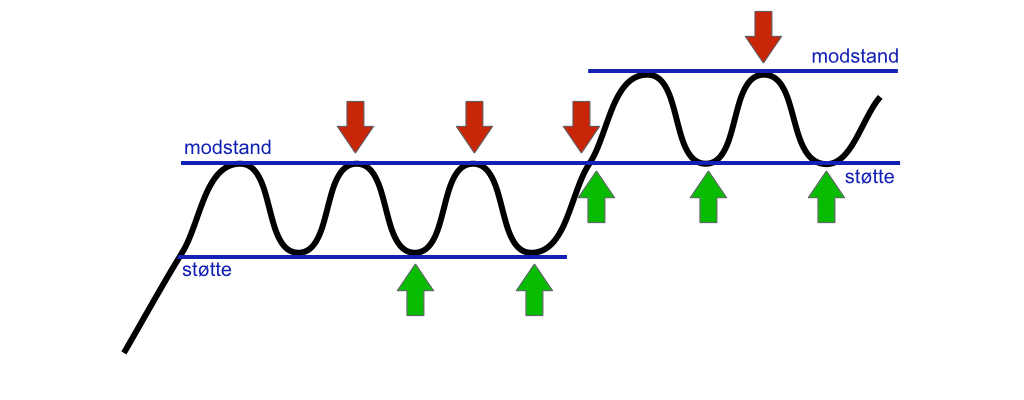
Figuren viser, hvordan man kan handle baseret på støtte og modstand. Køb nær støtte og sælg nær modstand. Køb ved brud på modstand.
I Investtechs grafer angives støtte med grønne horisontale linjer og modstand med røde linjer. Styrken i støtte- og modstandsniveauet angives med en til tre stjerner, hvor tre er kraftigst. Støtte vil altid være under dagens kurs, mens modstand altid vil være over.
Særlige situationer
Støtte og modstand er særligt vigtig, når markedet bevæger sig sidelænds. Da kan man opnå rigtigt gode resultater ved at købe nær støtte og sælge nær modstand.
Hvis en aktie er i en trendbevægelse, altså en stigende eller en faldende trend, vil trenden imidlertid overstyre støtte- og modstand.
Aktier i stigende trender
Stigende trender er generelt kraftige og pålidelige positive bevægelser. Stigende trender fortsætter længere end mange investorer tror og bryder ofte op gennem modstand. Når dette sker udløses købssignal, og kursen kan stige ekstra kraftigt.
I udgangspunktet skal man derfor – især hvis man er langsigtet – ikke sælge en aktie i en stigende trend, selv om den nærmer sig modstand.
Derimod kan man med fordel købe aktier i stigende trender, når kursen herudover nærmer sig horisontal støtte.
Aktier i faldende trender
For faldende trender gælder det modsatte af stigende trender.
Generelt skal man ikke købe aktier i faldende trender, selv om de nærmer sig støtte. Der er stor fare for brud ned, og dertil udløsning af salgssignal.
Derimod kan man med fordel sælge aktier i faldende trender, når kursen har reageret op mod horisontal modstand.
Identifikation af støtte og modstand
Støtte angiver niveauer, hvor der antages at ligge et overskud af købere. Modstand angiver niveauer, hvor der antages at ligge et overskud af sælgere. Investtech prøver at finde disse niveauer ved at se på, hvordan investorerne tænker.
Hvorfor vil en investor købe, når kursen falder til et bestemt kursniveau? Flere forhold gør sig gældende:
- Investoren mener, at aktien er fundamental billig på dette niveau.
- Investoren har set, at aktien tidligere er vendt op fra dette niveau, uden at have fået købt. Han eller hun ser, at andre har gjort gode handler og vil være med denne gang.
- Investoren har tidligere købt aktien på dette niveau og ved at det var en god handel. Han eller hun ønsker derfor at gentage succesen og køber igen.
- Investoren ser, at aktien nærmer sig et rundt tal, såsom 10, 20 eller 50. Det giver øget opmærksomhed. Det er samtidig lettere at tænke, at en aktie er billig, hvis den bryder et sådant niveau, end hvis den bevæger sig mellem for eksempel 36 og 38 kroner, og man ønsker derfor at købe i forvejen.
Omtrent tilsvarende gælder for, hvorfor investorer ønsker at sælge en aktie.
Følgende forhold er dermed vigtige ved identifikation af støtte og modstand:
- Toppe og bunde i kursgrafen (pivotpunkter). A i figuren.
- Kursniveauer, hvor mange aktier er omsat (højt akkumuleret volumen). B i figuren.
- Runde tal. C i figuren.
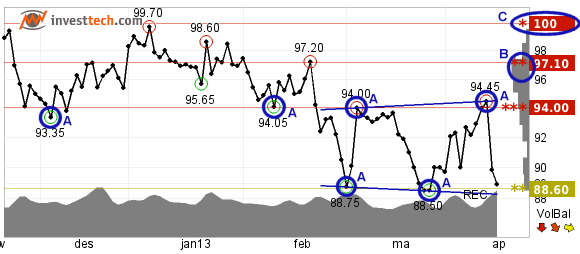
Investtech har computere, der kører matematiske rutiner for at finde de bedste støtte- og modstandsniveauer. Aktuelle niveauer bliver identificeret, og deres styrke beregnes ved blandt andet at se på, hvor mange tidligere toppe og bunde grafen har nær de aktuelle kurser. Beregningen gøres på ny hver dag, og alle kurserne i den gældende graf bliver brugt som input.
Price near support
Price is near support. The stock has reversed here before. Many investors now find it to be cheap and may wish to buy again.
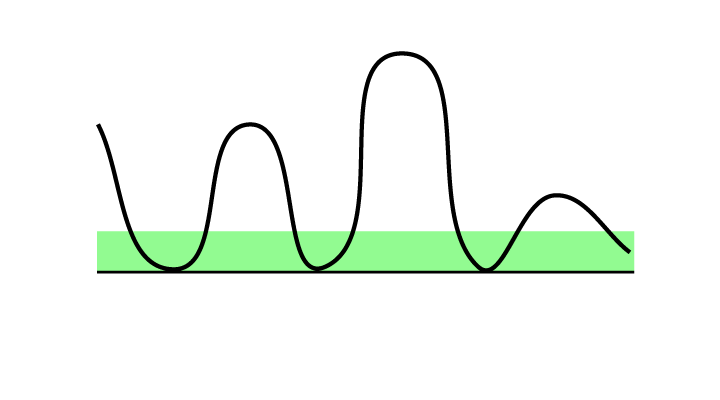 Price near support is an indication that the price will rise. The definition of support says that more and more buyers are active the closer the price gets to the support level. It can be favourable to set a buy order a little above the support level when wanting to buy such stocks.
Price near support is an indication that the price will rise. The definition of support says that more and more buyers are active the closer the price gets to the support level. It can be favourable to set a buy order a little above the support level when wanting to buy such stocks.
Please note that a break downward through support will trigger a sell signal. The price can potentially fall very much in a short time. It can be risky to buy on support especially if volume development is negative or the stock is in a falling trend.
Investtech research: Price near support
statSummaryRelNeg statSummaryRelNegNumber
| Annualised return (based on 66-day figures) | |
| Signaux positifs moyen terme | 8.9% |
| Reference index | 9.6% |
| Excess return | -0.7pp |
statSummaryTemplate
Lire plus
- Research Report: Investtech Research: Return for stocks testing support and resistance in stock prices, the Nordic markets, 1996-2018 (Niveau d'accès exigé: PRO)
- Research Article: Support and Resistance: Research results cause doubt about buy signals
- Research Report: Investtech-forskning: Støtte og motstand - signalstatistikk Norden 2019 og 2020 (Niveau d'accès exigé: PRO)
- Research Report: Investtech-forskning: Støtte og motstand - signalstatistikk Norden 2008-2020 (Niveau d'accès exigé: PRO)
- Research Article: Investtech-forskning: Farlig å kjøpe på støtte
Price near resistance
Price is near resistance. The stock has reversed here before. Many investors now find it to be expensive and may wish to sell.
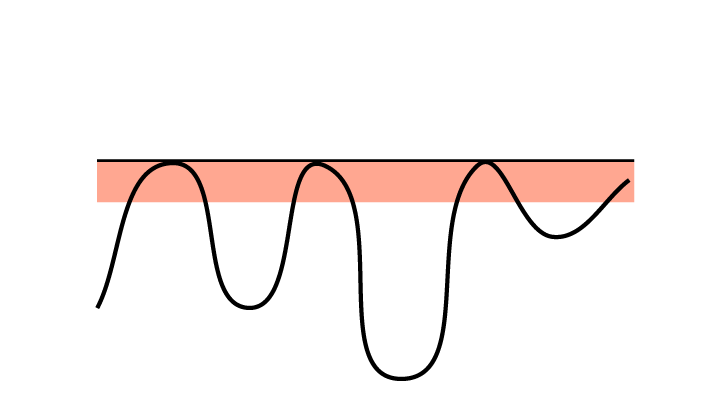 Price near a resistance level is an indication that the price will fall. The definition of resistance says that more and more sellers will be active the closer the price gets to the resistance level. It can be favourable to place a sell order a little below the resistance level when wanting to sell such stocks.
Price near a resistance level is an indication that the price will fall. The definition of resistance says that more and more sellers will be active the closer the price gets to the resistance level. It can be favourable to place a sell order a little below the resistance level when wanting to sell such stocks.
Please note that a break upward through resistance will trigger a buy signal. The price can potentially rise very much in a short time. Especially in the case of positive volume development or stocks in a rising trend, it can be a good idea to wait and not sell on resistance.
Investtech research: Price near resistance
statSummaryRelNeutral statSummaryRelPosNumber
| Annualised return (based on 66-day figures) | |
| Signaux négatifs moyen terme | 10.0% |
| Reference index | 9.7% |
| Excess return | 0.4pp |
statSummaryTemplate
Lire plus
- Research Report: Investtech Research: Return for stocks testing support and resistance in stock prices, the Nordic markets, 1996-2018 (Niveau d'accès exigé: PRO)
- Research Article: Support and Resistance: Profitable to buy stocks that are near resistance
- Research Report: Investtech-forskning: Støtte og motstand - signalstatistikk Norden 2019 og 2020 (Niveau d'accès exigé: PRO)
- Research Report: Investtech-forskning: Støtte og motstand - signalstatistikk Norden 2008-2020 (Niveau d'accès exigé: PRO)
- Research Article: Investtech-forskning: Svake signaler fra kurs nær støtte eller motstand
Break upward through resistance
A break upward through resistance is a buy signal. This is especially true if volume is also increasing. The sellers who used to be at this level are gone, but there is still buy pressure in the stock.
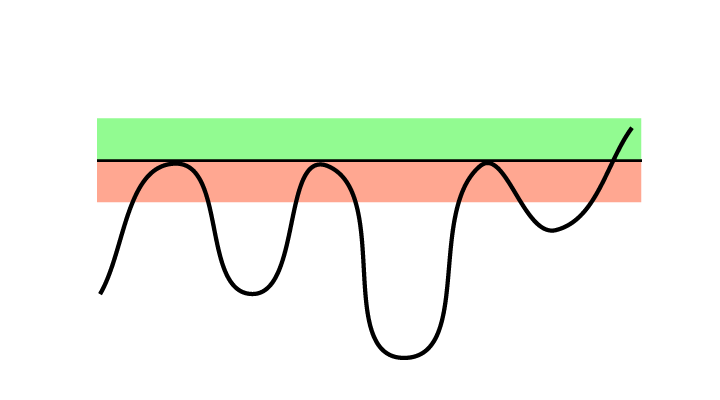 A stock that recently broke through a resistance level is expected to continue rising. Buying such stocks allows the investor to enter the stock early in a rising phase. If the stock has risen significantly since the break, a better price can be achieved by waiting for a reaction back.
A stock that recently broke through a resistance level is expected to continue rising. Buying such stocks allows the investor to enter the stock early in a rising phase. If the stock has risen significantly since the break, a better price can be achieved by waiting for a reaction back.
Please note that stocks in falling trends often give false buy signals on breaks upward through resistance. When buying such stocks, a long term and strong resistance level should be broken, and the break should be accompanied by increasing volume and positive volume development.
Investtech Research
The Nordic markets 1996-2018, a total of 43,367 buy signals.
Stocks with buy signal after break upwards through resistance have on average continued to rise and risen more than benchmark in the following months. Annualised return has been 5.1 percentage points better than benchmark
Read the research article here>>
Investtech research: Break upward through resistance
statSummaryRelPos statSummaryRelPosNumberSignificant
| Annualised return (based on 66-day figures) | |
| Signaux positifs moyen terme | 15.1% |
| Reference index | 11.0% |
| Excess return | 4.1pp |
statSummaryTemplate
Lire plus
- Research Report: Investtech Research: Return following testing of and breaks through support and resistance in stock prices, the Nordic markets, 1996-2018 (Niveau d'accès exigé: PRO)
- Research Article: Investtech Research: Support and Resistance - Summary
- Research Report: Investtech-forskning: Støtte og motstand - signalstatistikk Norden 2019 og 2020 (Niveau d'accès exigé: PRO)
- Research Report: Investtech-forskning: Støtte og motstand - signalstatistikk Norden 2008-2020 (Niveau d'accès exigé: PRO)
- Research Article: Investtech-forskning: Brudd opp gjennom motstand/ned gjennom støtte gir verdifulle tekniske signaler
Break downward through support
A break downward through support is a sell signal. Especially if volume is also increasing. The buyers who used to be at this level are gone, but there is still sales pressure in the stock.
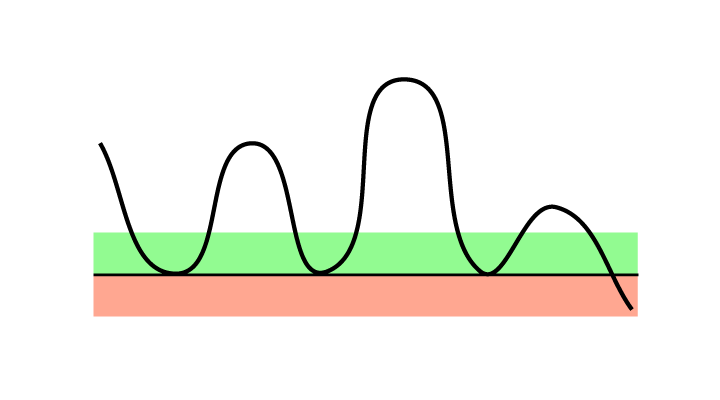 A stock that recently broke downwards through a support level is expected to continue to fall. Selling or not buying such stocks help the investor avoid the continued fall. If the stock has fallen significantly since the break, a better price can be achieved by waiting for a reaction back.
A stock that recently broke downwards through a support level is expected to continue to fall. Selling or not buying such stocks help the investor avoid the continued fall. If the stock has fallen significantly since the break, a better price can be achieved by waiting for a reaction back.
Please note that stocks in rising trends often trigger false sell signals on breaks downward through support. Investors who own such stocks should normally see a break downward through a long term, strong support level, preferably on high volume, before selling.
Investtech research: Break downward through support
statSummaryRelNeg statSummaryRelNegNumber
| Annualised return (based on 66-day figures) | |
| Signaux négatifs moyen terme | 8.4% |
| Reference index | 11.2% |
| Excess return | -2.8pp |
statSummaryTemplate
Lire plus
- Research Report: Investtech Research: Return following testing of and breaks through support and resistance in stock prices, the Nordic markets, 1996-2018 (Niveau d'accès exigé: PRO)
- Research Article: Investtech Research: Support and Resistance - Summary
- Research Report: Investtech-forskning: Støtte og motstand - signalstatistikk Norden 2019 og 2020 (Niveau d'accès exigé: PRO)
- Research Report: Investtech-forskning: Støtte og motstand - signalstatistikk Norden 2008-2020 (Niveau d'accès exigé: PRO)
- Research Article: Investtech-forskning: Brudd opp gjennom motstand/ned gjennom støtte gir verdifulle tekniske signaler
Price above support
The price is above a support level, where the stock has previously turned upwards. Many investors may consider it cheap if it falls towards support again, and may then wish to buy.
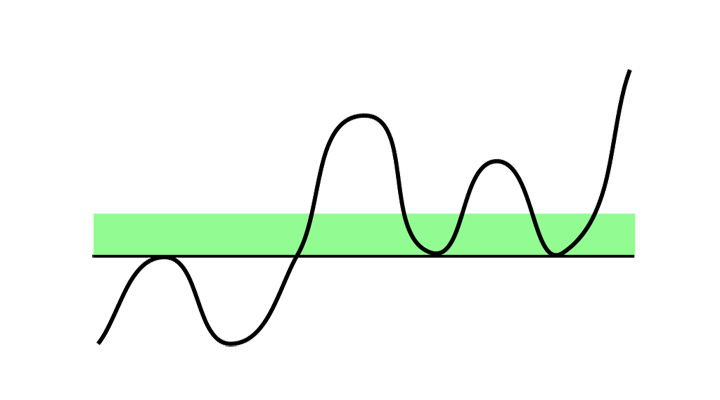 Support is where many buyers are thought to become active. It is normally assumed that the stock will not fall below support. Support is thus often used to calculate the downside potential in the stock, especially for short term investors. A stock with a long way down to support has a bigger downside than a stock near support.
Support is where many buyers are thought to become active. It is normally assumed that the stock will not fall below support. Support is thus often used to calculate the downside potential in the stock, especially for short term investors. A stock with a long way down to support has a bigger downside than a stock near support.
Especially in rising and horizontal trends, support expresses the downside potential in the stock. If, at the same time, there is little to no resistance above the current price, the upside potential tends to be high.
Investtech research: Price above support
statSummaryRelPos statSummaryRelPosNumberSignificant
| Annualised return (based on 66-day figures) | |
| Signaux positifs moyen terme | 18.2% |
| Reference index | 8.1% |
| Excess return | 10.1pp |
statSummaryTemplate
Lire plus
- Research Report: Investtech Research: Return for stocks that are above support and lack resistance and for stocks that are below resistance and lack support in price charts, the Nordic markets, 1996-2018 (Niveau d'accès exigé: PRO)
- Research Article: Support and Resistance: Buy signal when stock is above support and lacks resistance
- Research Article: Investtech Research: Support and resistance are important indicators
- Research Report: Investtech-forskning: Støtte og motstand - signalstatistikk Norden 2019 og 2020 (Niveau d'accès exigé: PRO)
- Research Report: Investtech-forskning: Støtte og motstand - signalstatistikk Norden 2008-2020 (Niveau d'accès exigé: PRO)
Price below resistance
The price is below a resistance level, where the stock has previously turned downwards. Many investors may consider it expensive if it rises up to resistance, and may then wish to sell.
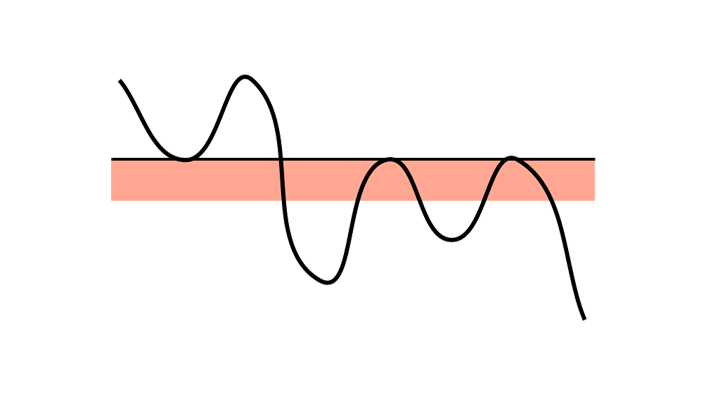 Resistance is a level where many sellers are thought to become active. It is normally assumed that the stock will not rise above the resistance level. Resistance is thus often used to calculate the upside potential of a stock, especially for short term investors. A stock with a long way up to resistance has a bigger upside potential than a stock near resistance.
Resistance is a level where many sellers are thought to become active. It is normally assumed that the stock will not rise above the resistance level. Resistance is thus often used to calculate the upside potential of a stock, especially for short term investors. A stock with a long way up to resistance has a bigger upside potential than a stock near resistance.
Especially in falling and horizontal trends, resistance expresses the upside potential in the stock. If, at the same time, there is little to no support below the current price, the downside potential tends to be big.
Investtech research: Price below resistance
statSummaryRelNeg statSummaryRelNegNumberSignificant
| Annualised return (based on 66-day figures) | |
| Signaux négatifs moyen terme | 4.5% |
| Reference index | 11.6% |
| Excess return | -7.1pp |
statSummaryTemplate
Lire plus
- Research Report: Investtech Research: Return for stocks that are above support and lack resistance and for stocks that are below resistance and lack support in price charts, the Nordic markets, 1996-2018 (Niveau d'accès exigé: PRO)
- Research Article: Support and Resistance: Buy signal when stock is above support and lacks resistance
- Research Article: Investtech Research: Support and resistance are important indicators
- Research Article: Støtte og motstand: Gode salgssignaler fra aksjer som ligger under motstand og mangler støtte
- Research Report: Investtech-forskning: Støtte og motstand - signalstatistikk Norden 2019 og 2020 (Niveau d'accès exigé: PRO)
Price between support and resistance
Price is between support and resistance. Many investors find it cheap near support and expensive near resistance. A break upward will be a buy signal, whereas a break downward will be a sell signal.
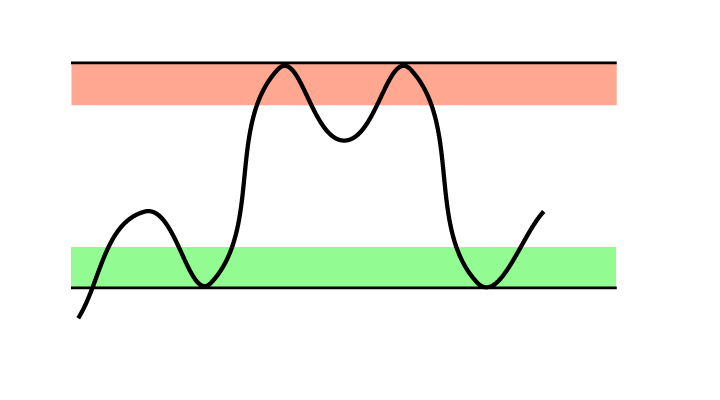 When the stock price is between a support level and a resistance level, without being particularly near either of them, it does not signal anything about the future stock price.
When the stock price is between a support level and a resistance level, without being particularly near either of them, it does not signal anything about the future stock price.
If the price is falling towards support, it indicates that it will reverse and rise again. This is especially the case if it is a rising trend.
If the price is rising towards resistance, it indicates that it will reverse and fall back again. This is especially the case if it is a falling trend.
Kurs i støtte/modstandskanal
Kursen ligger i en smal kanal mellem støtte og modstand. Brud op vil være købssignal, mens brud ned vil være salgssignal.
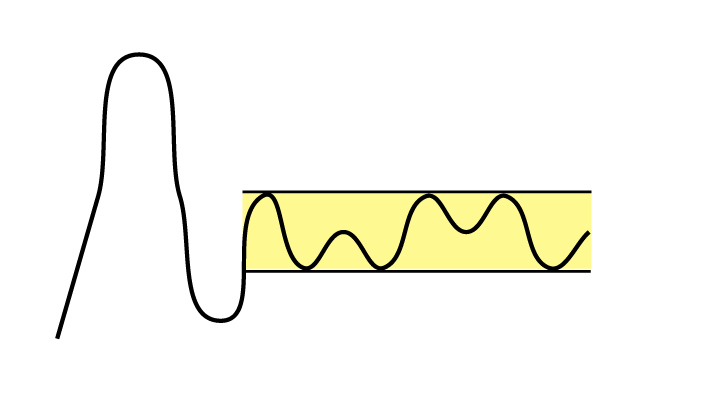 Når kursen ligger i et område, hvor den har vendt flere gange tidligere, og der har været høj omsætning, siger vi, at den ligger i en støtte/modstandskanal. Ofte vil kursen fortsætte en sådan sidelænds udvikling en stund. Der bygges da let en spænding op i aktien. Når kursen bryder ud af kanalen, kan et kraftigt købs- eller salgssignal udløses.
Når kursen ligger i et område, hvor den har vendt flere gange tidligere, og der har været høj omsætning, siger vi, at den ligger i en støtte/modstandskanal. Ofte vil kursen fortsætte en sådan sidelænds udvikling en stund. Der bygges da let en spænding op i aktien. Når kursen bryder ud af kanalen, kan et kraftigt købs- eller salgssignal udløses.
Ofte vil sådanne situationer medføre, at der dannes en rektangelformation i grafen. Særligt brud op fra sådanne formationer har vist sig at være pålidelige købssignaler.
Investtech guarantees neither the entirety nor accuracy of the analyses. Any consequent exposure related to the advice / signals which emerge in the analyses is completely and entirely at the investors own expense and risk. Investtech is not responsible for any loss, either directly or indirectly, which arises as a result of the use of Investtechs analyses. Details of any arising conflicts of interest will always appear in the investment recommendations. Further information about Investtechs analyses can be found here disclaimer.
The content provided by Investtech.com is NOT SEC or FSA regulated and is therefore not intended for US or UK consumers.
Investtech guarantees neither the entirety nor accuracy of the analyses. Any consequent exposure related to the advice / signals which emerge in the analyses is completely and entirely at the investors own expense and risk. Investtech is not responsible for any loss, either directly or indirectly, which arises as a result of the use of Investtechs analyses. Details of any arising conflicts of interest will always appear in the investment recommendations. Further information about Investtechs analyses can be found here disclaimer.
The content provided by Investtech.com is NOT SEC or FSA regulated and is therefore not intended for US or UK consumers.


 Oslo Børs
Oslo Børs Stockholmsbörsen
Stockholmsbörsen Københavns Fondsbørs
Københavns Fondsbørs Helsingin pörssi
Helsingin pörssi World Indices
World Indices US Stocks
US Stocks Toronto Stock Exchange
Toronto Stock Exchange London Stock Exchange
London Stock Exchange Euronext Amsterdam
Euronext Amsterdam Euronext Brussel
Euronext Brussel DAX
DAX CAC 40
CAC 40 Mumbai S.E.
Mumbai S.E. Commodities
Commodities Currency
Currency Cryptocurrency
Cryptocurrency Exchange Traded Funds
Exchange Traded Funds Investtech Indices
Investtech Indices